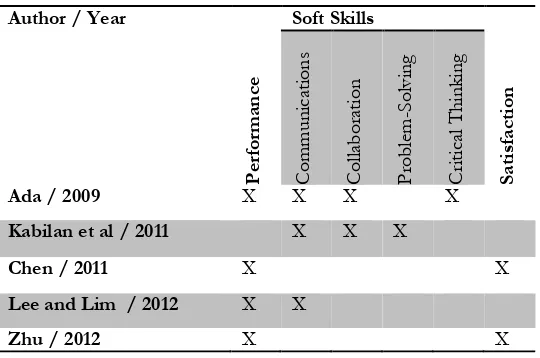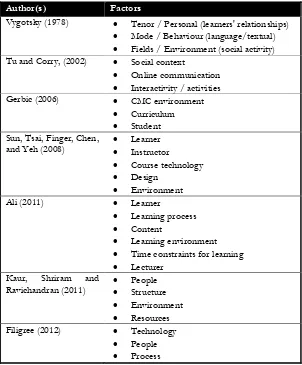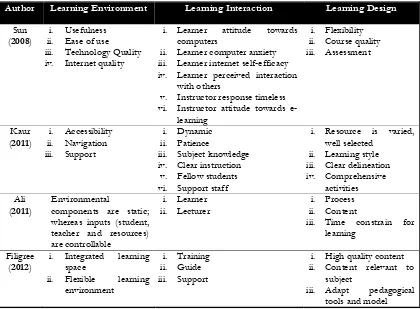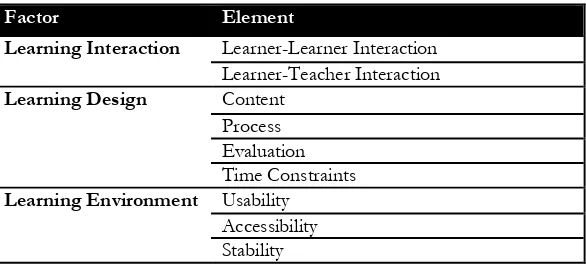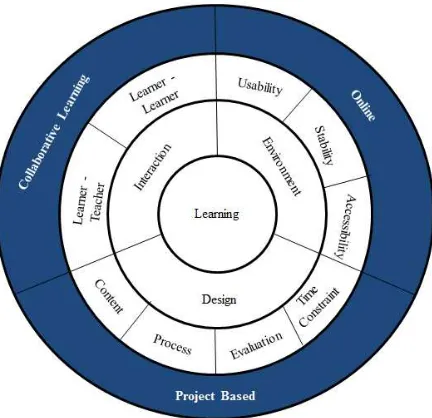Online Collaborative Learning Elements to Propose An Online Project
Based Collaborative Learning Model
Sharifah Nadiyah Razalia*
Faaizah Shahbodina
, Hanipah Hussinb
, Norasiken Bakara
a
Faculty of Information and Communication Technology, Universiti Teknikal Malaysia Melaka b Centre for Language and Human, Universiti Teknikal Malaysia Melaka
E-mail: [email protected]
Abstract: Interest in collaboration is a natural outgrowth of the trend in education toward active learning. Many researchers have found that the advantages of collaborative learning; improves academic performance, promotes soft skills development (i.e., communications, collaboration, problem-solving and critical thinking skills), and increases satisfaction in the learning experience. Nevertheless, several studies have reported the complete opposite. In that respect, based on previous findings, three elements that are involved in the effectiveness of Online Collaborative Learning Environments are; Learning Environment, Learning Task, and Learning Interaction. This report proposes to determine the elements that can clarify all of the previously identified factors. Using the same approach as prior work, this study was conducted qualitatively; in the form of a document review. The outcome of this work suggests that (i) the learning interaction factor consists of learner-learner interaction and learner-teacher interaction elements, (ii) the elements of the learning design factor are content, process, evaluation, and time constraint, and (iii) usability, accessibility and stability are the ingredients of the learning environment factor. This study also proposes an Online Project-Based Collaborative Learning model. This model is currently only in a conceptual phase and requires significant development before it can be used to gather data. Therefore, in the next stage of this study, a prototype will be designed and developed; based on the proposed model.
Keywords: Collaborative Learning, Online Collaborative Learning, Learning Environment, Learning Interaction, Learning Design;
1. Introduction
The benefits of collaboration in learning have been proven by Social Constructivism (Vygotsky, 1978). According to Johnson and Johnson (1989), learning tends to be most effective when students are in a position to work collaboratively in expressing their thoughts; discussing and challenging ideas with others, and working together towards a group solution to a given problem. Zhu (2012) defines Collaborative Learning as a social interaction involving the acquisition and sharing of experience or knowledge amongst learners and teachers. Collaborative learning, which in an online environment is typically referred to as online teams or groups, refers to instructional activities to get students to work together online to achieve common educational goals.
The benefits of Collaborative Learning are summarized in Table I. environment. She found a positive relationship between the quality of the collaborative process and the quality of the cognitive skills fostered. Furthermore, she also found that effective collaborative learning can contribute to the establishment of a learning community, and it fosters high order thinking through knowledge processes. Due to the tedious and time-consuming coding process, she suggested that other researchers should computerize the coding process.
Research by Kabilan, Adlina, and Embi (2011) reported on pre-service teachers’ meaningful experiences in collaborative projects and how they had enriched their professional development. The results showed their professional development engagements were enriched by envisioning professional development, gaining and enhancing five skills (i.e., planning and researching, problem-solving, the fundamental notion of learning, language skills, and computing skills), sharing and exchanging information, knowledge ideas, views and opinions related to the tasks given, and teachers socializing both within and between groups. For future research, they suggested that other researchers should also focus on additional popular online platforms, such as Facebook, Academia.edu and LinkedIn, as tools for their online professional development projects.
With the growth of Web 2.0 technology, Chen (2011) investigated the differences between
students’ learning outcomes and satisfaction in class, using an online social networking tool
(Facebook) among different learning styles. There were four learning styles; Diverger, Assimilator, Converger, and Accommodator. He found that the Converger group performed better and showed a more positive attitude towards Facebook the other learning style groups. In
the Converger group’s perception, Facebook facilitated interaction with others and improved content understanding in the class. For future study, he suggested examining the effects on different levels of learners, in order to link the relationship of learning styles and the online social networking tool (Facebook).
Lee and Lim (2012) investigated the important issues that arose when students evaluated their peers in team project-based learning, by analysing each message and comparing them to
their peer’s evaluation results. They classified the messages into four types; managerial, procedural, social, and academic messages. The findings showed that all message types, except
academic messages, predicted the peer’s evaluation results. They concluded that students found
social contribution to be more important than cognitive contribution when evaluating their peers. They suggested that other research should be done to compare the relationship between
Zhu (2012) found that online collaborative learning can enhance students’ knowledge construction. He examined satisfaction with the online learning environment, online performance, and knowledge construction via the online group discussions of students from two different cultural contexts (Flemish and Chinese). The results showed that there was a relationship between student satisfaction and academic achievement in an innovative e-learning environment. It also showed that online learning systems can enrich students’ collaborative learning activities, as well as their knowledge construction, via group interaction. However, it was also found that instructors evaluated the quality of the final product without knowledge of the teamwork process. It was therefore suggested that, in the future, researchers may want to, not only study cognitive learning outcomes, but also social skills in collaborative learning outcomes.
Contrary to this, other research has shown evidence that online learning can pose an even greater challenge for collaborative work than face-to-face (F2F) learning. According to Chiong and Jovanovic (2012), establishing and maintaining an active collaboration is a challenging task, due to a lack of active participation by group members in their group work. Results from interview sessions on Collaborative Learning experience, in a research by Zhang and Han (2008), showed that tension exists within group towards the fairness of being given the same mark.
Educators are not able to assume that every student makes an equal contribution to a group’s
work and allocate the same marks to all members (Wang, 2010). Educators must allocate marks
based on a student’s contribution, in order to encourage students to actively participate in their group’s work activity (Swan, Hiltz, & Shen, 2006).
Lee and Lim (2012) found that instructors may not observe all the processes occurring within student groups; and that evaluations are only done on the quality of the final product – thus ignoring the teamwork process. They suggested that instructors should closely monitor group interaction messages and complete peer evaluations. Wang (2009) also suggested that educators, including teachers and lecturers, should closely monitor how their students work together in a collaborative learning process for effective learning to take place. Monitoring the
From prior work, those factors affecting the effectiveness of Online Collaborative Learning environments are summarized in Table 2.
Table 2 Factors that affect the effectiveness of online collaborative learning environments
Author(s) Factors
Vygotsky (1978) Tenor / Personal (learners' relationships) Mode / Behaviour (language/textual) Fields / Environment (social activity) Tu and Corry, (2002) Social context
Online communication Interactivity / activities
Gerbic (2006) CMC environment
Curriculum Student Sun, Tsai, Finger, Chen,
and Yeh (2008)
Learner Instructor Course technology Design
Environment
Ali (2011) Learner
Learning process Content
Learning environment Time constraints for learning Lecturer
Kaur, Shriram and Ravichandran (2011)
People Structure Environment Resources Filigree (2012) Technology
People Process
Previous authors have determined the factors to be considered in creating an effective online collaborative learning environment. The results indicate that three main factors affect the effectiveness of Online Collaborative Learning Environments, namely Learning Environment, Learning Design, and Learning Interaction. This study aims to determine the elements that clarify all of these previously identified factors and propose an Online Project-Based Collaborative Learning model.
2. Materials and Methods
3. Findings and discussion
From the prior work,authors have determined the three factors of learning environment, learning interaction and learning design. This section will describe the elements that can clarify these factors. Based on a review of documents, different elements clarified the same factor; as defined by different researchers (see Table3).
Table 3Online Collaborative Learning Elements
Author Learning Environment Learning Interaction Learning Design
Sun vi. Instructor attitude towards
e-learning usefulness, ease of use, technology quality and internet quality elements. Meanwhile, Kaur et al. (2011) supported different elements, such as accessibility, navigation and support. In the other hand, Ali (2011) stated that the environment should be static and student, teacher and resources controllable. Filigree (2012) stated that it should include integrated learning spaces and flexible learning environments. According to Moore, Dickson-Deane and Galyen (2011), the learning environment factor refers to tools that can be used within the environment, or the type of learning that will be delivered within the system.
In this study, the elements that clarify the learning environment factor will be usefulness, ease of use, stability and accessibility. According to the TAM model, proposed by Davis (1989), usability defines the usefulness and ease of use of the technology. He identified perceived usefulness as being the degree of work performance after implementation of a system, and
perceived ease of use as the users’ perception on ease of implementation of the system.
In the learning interaction factor, six elements were identified by Sun et al. (2008) as Learner attitude towards computers, Learner computer anxiety, Learner internet self-efficacy, Learner perceived interaction with others, Instructor response timeless and Instructor attitude towards e-learning. However, Kaur (Kaur et al., 2011) found that dynamics, patience, subject knowledge, clear instruction, fellow students, and support staff, were all elements of the learning interaction factor. Ali (2011) defined it as learner and lecturer elements, and Filigree (2012) suggested it should consist of training, guide, and support elements.
Interaction is the backbone of any online learning (Kaur et al., 2011). A successful course will have a high proportion of student-student interaction. This interaction can make the course come to life. A number of studies to define the relationship between learner interaction found that the early stages of a collaborative learning environment only involves (Gerbic, 2006; Tu & Corry, 2002; Vygotsky, 1978). However, recent studies have defined interactivity as, not only involving learners with learners, but also involving the relationship between learners and teachers (Ali, 2011; Filigree, 2012; Kaur et al., 2011; Sun et al., 2008). In this study, authors will use learner-learner interaction and learner-teacher interaction based on (Moore, 1989).
For the learning design factor, Sun et al. (2008) concluded that it should consist of flexibility, course quality, and assessment. Meanwhile, Kaur et al. (2011) said that the resource should be varied and well selected, consider student learning style, use clear delineation and provide comprehensive activities. Ali (2011) defined it differently as process, content and time constraint for learning. Filigree (2012) identified the elements of high quality content, content relevant to subject, and adapt pedagogical tools and model. Chanchalor and Somchitchob (2007) suggested that these learning activities must be well planned. Therefore, all developers must choose appropriate technologies and create motivating learning designs. In this study, the author will use content, process, time constraint and assessment elements to clarify the learning design factor. All elements that clarify each factor have been summarized in Table 4 below.
Table 4Factors and elements of Online Collaborative Learning
Factor Element
Learning Interaction Learner-Learner Interaction Learner-Teacher Interaction
Learning Design Content
Process Evaluation Time Constraints Learning Environment Usability
Accessibility Stability
Figure 1 Propose An Online Project Based Collaborative Learning Model
4. Conclusion
Although technology is seen as an important enabler for improving student-learning outcomes; to get the greatest value from technology, best practices are required. Five levels of collaboration maturity were proposed by Filigree (2012), namely Basic, Partially Implemented, Integrated, Collaborative and Transformative. The report emphasized that collaborative learning is heavily rooted in the idea that learning is inherently social and can be facilitated with technology and proper practices. Collaborative learning, not only promotes social skills, but also facilitates retention, improves the experience and enhances creativity. With higher levels of collaboration, greater results will be delivered. The factors and elements identified in the previous sections will be used to design and develop an Online Project-Based Collaborative Learning prototype in the next stage of this research. Currently, the model is only in a conceptual phase and requires significant development before it can be used to gather data.
Acknowledgement.
Sharifah Nadiyah Razali would like to gratefully acknowledge the financial support of Universiti
References
Ada W. W. MA. (2009). Computer supported collaborative learning and higher order thinking skills: A case study of textile studies.
Interdisciplinary Journal of E-Learning and Learning Objects, 5, 145–167.
Ali, H. (2011). A comparison of cooperative learning and traditional lecture methods in the project management department of a tertiary level institution in Trinidad and Tobago. The Caribbean Teaching Scholar, 1(1), 49–64.
Best, J. W., & Kahn, J. V. (1998). Research In Eduction. United State of America: A Viacom Company.
Chanchalor, S., & Somchitchob, S. (2007). A study of the utilisations on cooperative learning technology of short course students towards basic blouse making course. The International Journal of Learning, 14(7), 57–63.
Chen, Y. (2011). Learning styles and adopting Facebook technology. Technology Management in the Energy Smart World (PICMET) (pp. 1–9).
Chiong, R., & Jovanovic, J. (2012). Collaborative Learning in Online Study Groups: An Evolutionary Game Theory Perspective. Journal of
Information Technology Education: …, 11, 81–101.
Davis, F. (1989). Perceived Usefulness, Perceived Ease of Use, and User Acceptance of Information Technology. MIS Quarterly, 13(3), 319–340.
Filigree, C. (2012). Instructional Technology and Collaborative Learning Best Practices : Global Report and Recommendations. Gerbic, P. (2006). To post or not to post: Undergraduate student perceptions about participating in online discussions. Proceedings of the
23rd annual ascilite conference: Who’s learning? Whose technology?, (1995), 271–281.
Johnson, D.W., & Johnson, R. T. (1989). Cooperation and competition: Theory and research. Edina, MN: Interaction Book Company. Kabilan, M. K., Adlina, W. F. W., & Embi, M. A. (2011). Online Collaboration of English Language Teachers for Meaningful Professional
Development Experiences. English Teaching: Practice and Critique, 10(4), 94–115.
Kaur, A., Shriram, R., & Ravichandran, P. (2011). A Framework for Online Teaching and Learning: The S-CARE Pedagogical Model. 25th
AAOU Annual Conference (pp. 1–12).
Lee, H.-J., & Lim, C. (2012). Peer Evaluation in Blended Team Project-Based Learning; What Do Students Find Important? Educational
Technology & Society, 15(4), 214–224.
Moore, J. L., Dickson-Deane, C., & Galyen, K. (2011). e-Learning, online learning, and distance learning environments: Are they the same?
The Internet and Higher Education, 14(2), 129–135.
Moore, M. G. (1989). Three types of interaction. The American Journal of Distance Education, 3(2), 1–6.
Razali, S. N., Shahbodin, F., Bakar, N., Hussin, H., & Ahmad, M. H. (2014). Perceptions towards the Usage of Collaborative Learning in Teaching and Learning Processes at. International Conference on Advances In Computing, Communication and Information
Technology.
Sallabas, M. E. (2013). Analysis of narrative texts in secondary school textbooks in terms of values education. African Journal of Business
Education, 1(3), 59–63.
Stewart, A. M. (2009). Research Guide for A Students and Teachers.
Strauss, A., & Corbin, J. (1990). Basics of qualitative research: Grounded theory procedures and techniques. Newburry Park: CA: Sage. Sun, P., Tsai, R., Finger, G., Chen, Y., & Yeh, D. (2008). What drives a successful e-Learning? An empirical investigation of the critical
factors influencing learner satisfaction. Computers & Education, 50, 1183–1202.
Swan, K., Hiltz, S. R. S., & Shen, J. (2006). Assessment and collaboration in online learning. Journal of Asynchronous Learning Networks,
10(1), 45–62.
Tu, C.-H., & Corry, M. (2002). Social presence and critical thinking for online learning. Annual Conference of American Educational
Research Association (AERA).
Vygotsky, L. S. (1978). Mind in Society. Cambridge (Massachusetts): Harvard University Press.
Wang, Q. (2009). Design and evaluation of a collaborative learning environment. Computers & Education, 53(4), 1138–1146. Wang, Q. (2010). Using online shared workspaces to support group collaborative learning. Computers & Education, 55(3), 1270–1276. Zhang, Z., & Han, Z. (2008). A Phenomenographic Study into Conceptions of Social Relations in Online Collaborative Learning - Case
Study of China Higher Education Learners. IEEE International Conference on Computer Science and Software Engineering (ICCSSE)
(pp. 146–149). Ieee.
